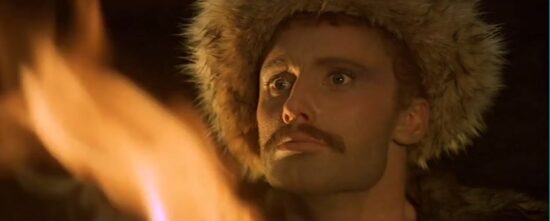Seweryn Kuśmierczyk
Pociąg (Night Train). An Analysis of the Meeting Scene
The present analysis focuses on the scene in which the protagonists meet in the Pociąg (Night Train or Baltic Express) movie. The film was directed by Jerzy Kawalerowicz, and the cinematography was created by Jan Laskowski.
The shots of the train in motion were filmed in a studio, in an immobile train car that was adapted for this purpose. The camera was placed on a narrow cart and moved along a corridor, passing standing people as if it was a passenger walking by. The moving landscape visible from the windows was created by rear projection. The film was projected with a landscape on an external screen with a system of mirrors.
The movement typical for a moving train was created by crew members – as they pushed the bumpers.
Let us focus on the means of expression that were used to construct the scene and present the unity of content and form. We will pay attention to the enclosed space in which the characters are placed and to its significance for their relations. We will also discuss the frame composition and the presence of light. Furthermore, we will examine costumes and the auditory layer.
The cameras low point of view point draws ones attention to the place where the man notices a female purse. Then, its owner enters the compartment and this moment is highlighted by an auditory layer as the train starts to whistle.
The intensive flickering of the light and the chiaroscuro effect visible on the wall of the compartment highlights the characters uneasiness resulting from the meeting. The tension is, naturally, shown in their acting as well.
Marta looks down outside the train window. She does not see the landscape, focusing on the railway instead. The viewer may interpret this image as one that reflects the protagonists mental state, or a representation of her sadness. When the door to the compartment opens, her face is lit by a special reflector used by Jan Laskowski, the cinematographer. This lighting will accompany the character throughout the entire journey. It is visible on her face as she is sitting.
The chiaroscuro effect, which emphasises the sad situation in which the protagonists finds herself, reappears. The open doors divide the frames into halves.
On the left, there is the trapped Marta. On the right, one can see her antagonists.
The flickering light visible on the compartments wall emphasises Marta’s conflict with the ticket inspector.
When the ticket inspector intervenes again, a low camera angle is used one more time. It creates a framework that closes the scene and presents the disagreement about who has the right to travel in the compartment.
When the man takes his grey jacket off, only two colours remain in the characters’ clothes: black and white. The contrast reflects the opposing difficulties both of the characters find their travel in the compartment.
The mirror hanging on the wall and the reflection visible in the window pane, as well as the music, seem to signal the journey into the characters’ inner world that is about to begin.
Two strangers placed in one small room seem to create their own space that separates them from their fellow travellers.
The book and the newspaper serve as the imaginary borders. This is how the journey begins. Jerzy Kawalerowicz’s characters will surely remember it for a long time.



